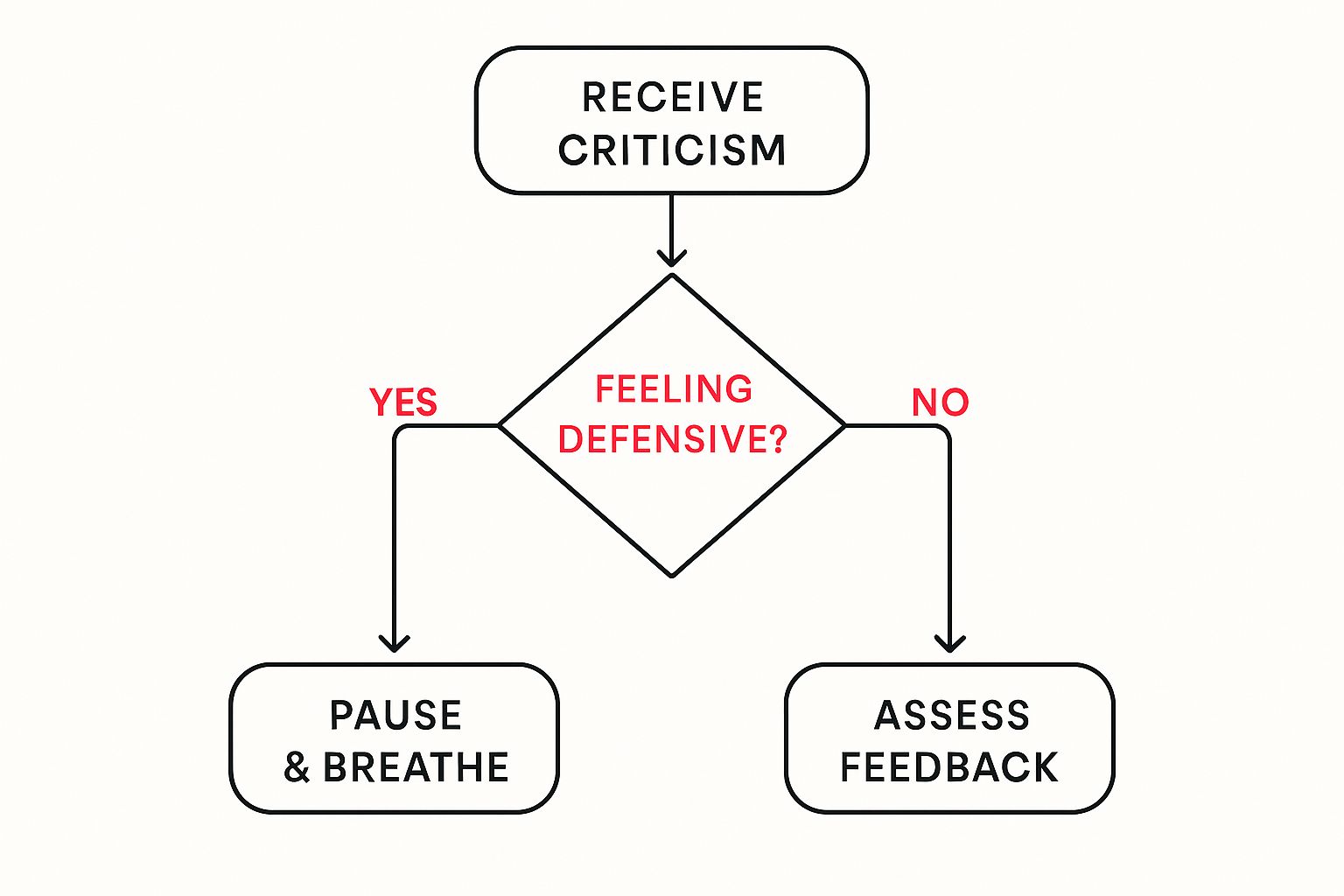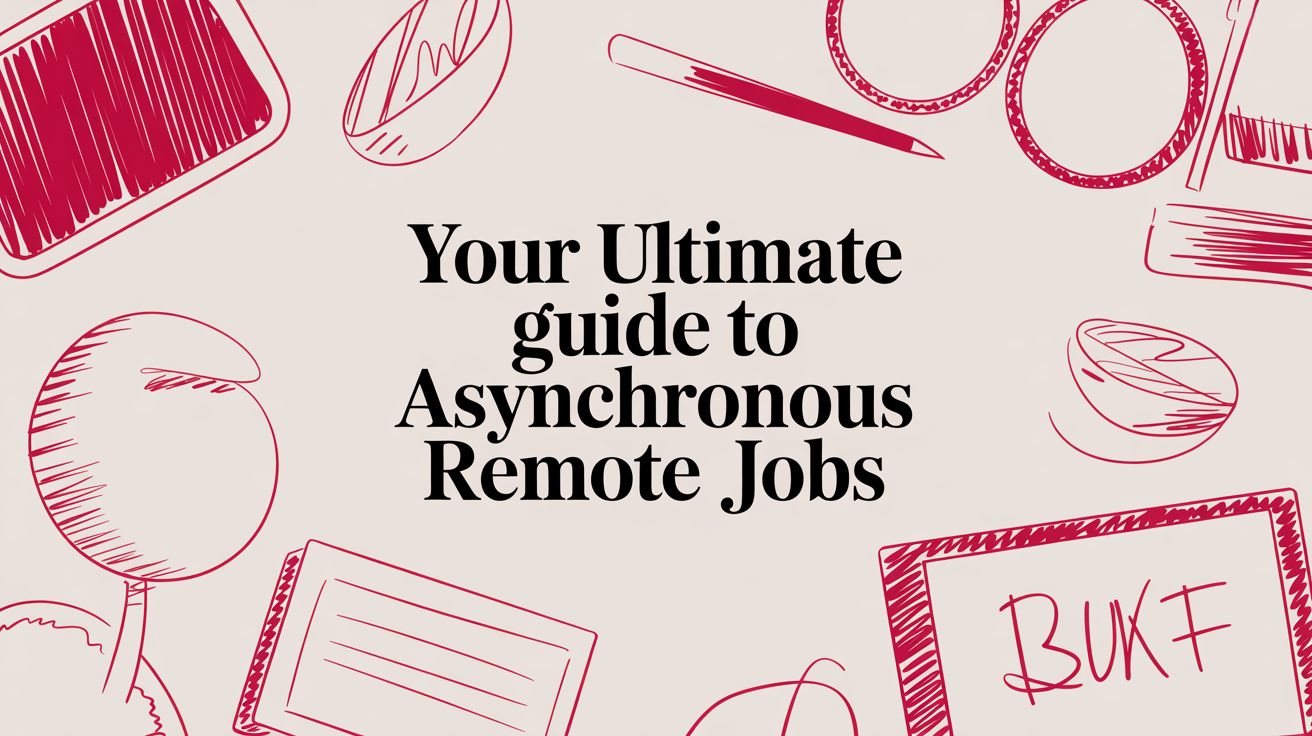How Do You Handle Criticism? Tips for Building Resilience
Max
The Psychology Behind Criticism in Professional Life

Why does criticism at work feel so different from feedback in our personal lives? At work, criticism can feel like a threat to our position, job security, and career prospects. This triggers a natural “fight or flight” response, making rational processing difficult. The overall company culture also plays a significant role.
For example, in a highly competitive atmosphere, small critiques can feel like significant setbacks. However, in a supportive environment that encourages growth, feedback is seen as a chance to improve. The way criticism is phrased also matters. Vague feedback can cause anxiety, while specific, actionable advice is easier to handle.
The Influence of Workplace Dynamics
How we react to criticism isn’t just a personal thing; it’s greatly affected by our workplace. In a culture of open and regular feedback, employees tend to develop criticism resilience. But if feedback is rare or poorly given, even helpful criticism can be taken the wrong way.
Understanding your workplace’s dynamics is key to handling criticism well. Our personal history also plays a role. Past experiences with negative feedback, especially early in life, can shape how we interpret criticism at work.
Recognizing Your Criticism Triggers
Just as certain situations make us more sensitive, some types of comments trigger stronger reactions. Identifying your personal criticism triggers is crucial for effective management. You might be sensitive to feedback on public speaking, while others might find comments on their writing more upsetting.
Knowing these triggers helps you anticipate and manage your reactions, allowing for constructive responses, even when the feedback feels personal. A study by The Myers-Briggs Company found that 85% of employees experience some workplace conflict, often involving criticism. Around 29% experience frequent conflict, meaning almost one in three workers regularly face challenging feedback. You can find more details here: Learn more about workplace conflict. Clearly, good strategies for handling criticism are essential for professional success.
Decoding Feedback: Constructive vs. Destructive Criticism
Not all feedback is helpful. Learning to effectively handle criticism hinges on understanding the difference between constructive criticism, which helps you improve, and destructive criticism, which often aims to hurt or belittle. This is a vital skill for navigating your career and personal development. The following infographic offers a simple process for handling criticism: Are you feeling defensive? If yes, pause and breathe. If not, assess the feedback.

This visualization highlights the importance of managing your initial emotional response. Taking a breath allows you to approach feedback objectively.
Identifying Constructive Criticism
Constructive criticism is specific, actionable, and offered with good intentions. It focuses on behaviors and actions you can change, not personal attacks. For example, instead of “You’re disorganized,” constructive feedback might be, “I’ve noticed project deadlines are slipping. Could we discuss how to improve the project timeline?” This provides specific points for improvement and opens a discussion.
Constructive criticism also often includes suggestions. It looks ahead to how you can grow and adjust your approach. This forward-thinking aspect sets it apart from destructive criticism, which tends to focus on past mistakes.
Recognizing Destructive Criticism
Destructive criticism is often vague, personal, and designed to erode your confidence. It can include insults, generalizations, and harsh judgments about your character. This kind of feedback rarely helps and needs to be handled differently than constructive feedback.
Destructive criticism tends to target the person, not the issue. Think of comments like, “You’re always late” or “You never listen.” These target your character rather than giving specific examples or offering solutions. Recognizing these patterns helps you filter out unproductive feedback.
To better understand the difference between constructive and destructive criticism, let’s examine a practical comparison:
To help clarify these differences, and guide your response strategies, the following table offers a detailed comparison of constructive and destructive criticism, along with advice on how to respond to each type.
Constructive vs. Destructive Criticism: Your Response Guide
A practical comparison revealing how to identify different types of criticism and implement effective response strategies tailored to each situation
| Characteristic | Constructive Criticism | Destructive Criticism | How to Respond |
|---|---|---|---|
| Intent | To help improve | To harm or demean | |
| Specificity | Specific examples provided | Vague and generalized | With constructive criticism, ask clarifying questions. With destructive criticism, don’t engage unless necessary for professional reasons. |
| Focus | On behavior or action | On personal traits | |
| Delivery | Supportive and respectful | Aggressive or condescending | If you receive destructive criticism publicly, calmly and politely address the inappropriateness of the comments. |
| Outcome | Promotes growth and development | Damages confidence and morale | |
| Example | “The report could benefit from more data to support the conclusions.” | “This report is terrible. You’re clearly not competent.” |
This table summarizes the key differences, emphasizing how constructive feedback offers pathways for improvement, while destructive feedback focuses on personal attacks. Learning to differentiate these two types is key to effectively navigating feedback.
Asking the Right Questions
When you receive feedback, ask yourself these key questions: Is the criticism specific? Does it include real examples? Does it suggest actionable steps? Is it delivered respectfully? These questions give you a structure for evaluating the feedback’s value and figuring out the best way to handle it.
By filtering feedback this way, you can gain insights from constructive criticism while shielding yourself from the negative impact of destructive comments. This skill of separating helpful from harmful feedback is fundamental for professional success and emotional resilience. It lets you embrace growth opportunities while maintaining your confidence and well-being.
First Response Toolkit: Managing Your Emotional Reaction

Those first few moments after receiving criticism can be incredibly impactful. Your initial reaction often determines whether you perceive the feedback as valuable insight or a personal affront. This is why managing your emotional response is the first, and most important, step in effectively processing criticism.
Breathing and Reframing: Creating Emotional Space
The key to managing any emotional reaction is creating space for yourself. You want to avoid impulsive actions or words that you might later regret. One highly effective method is mindful breathing. Taking a few deep, slow breaths can calm your nervous system, paving the way for a more measured response.
Try to mentally reframe the situation. Rather than viewing the criticism as a negative judgment of your character, consider it an opportunity for growth. This shift in perspective can significantly de-escalate your initial emotional reaction and allow you to engage with the feedback constructively.
The Pause Button: Phrases for Composure
Certain phrases can act as a “pause button,” preventing knee-jerk reactions. Statements like, “Thank you for sharing this with me. I’d like some time to consider what you’ve said,” or “I appreciate you bringing this to my attention. Can we discuss this later?” give you valuable time to process the information.
These phrases also convey professionalism and a willingness to engage with the feedback, even if you’re feeling defensive. This positive approach sets a good tone for future conversations and helps maintain a productive working relationship.
Emotional Regulation: Tailoring Your Response
Everyone responds to criticism differently. A strategy that works for one person might not be effective for another. Developing a personalized emotional regulation system is essential. Some individuals find taking a short walk or listening to music calming. Others may find journaling or talking to a trusted friend more beneficial. Experiment to find what best suits your needs.
When processing feedback, it’s helpful to understand the intentions behind it. You can review information on giving constructive feedback. It’s also important to recognize that company culture and morale can influence how you react emotionally. Recent data shows global employee engagement is down to only 21%, often correlated to how employees perceive and handle feedback. More detailed statistics can be found here. This decline highlights the importance of fostering a work environment where criticism is viewed as a tool for growth, not negativity. By developing a personalized approach to emotional regulation, you can effectively navigate and even benefit from critical feedback.
Criticism to Action: Your Feedback Implementation Plan
Turning criticism into meaningful improvement requires a structured approach. It’s about more than simply acknowledging the feedback; it’s about formulating a concrete plan to implement actual changes. This involves carefully evaluating the feedback’s validity, prioritizing key areas for improvement, and setting measurable goals.
Evaluating Feedback and Prioritizing Action
Not all criticism is created equal. Some feedback is highly relevant and actionable, while other comments might be less valuable or even misplaced. A key step in handling criticism effectively is developing a framework for assessing its objectivity. Ask yourself: Does this criticism align with my goals? Is it specific and actionable? Does the person offering the feedback have relevant expertise or experience?
After evaluating the feedback’s validity, prioritize the points that deserve immediate attention. Focus on the areas where improvement will have the biggest impact on your performance or development. This strategic approach allows you to maximize your efforts and see tangible results.
Developing Measurable Milestones and Clarifying Questions
Once you’ve prioritized areas for improvement, establish measurable milestones. These milestones break down larger objectives into smaller, more achievable steps. For example, if the criticism concerns time management, a milestone could be “Improve project completion time by 10% within the next quarter.” This provides a specific target and allows you to track your progress.
Asking clarifying questions is essential for deepening your understanding of the criticism without appearing defensive. Instead of asking, “What do you mean by that?”, try phrasing it as, “Can you give me an example of where I could have handled this situation differently?” This demonstrates a genuine desire to learn and improve. You might be interested in: How to stay motivated working from home. Staying motivated, even while handling criticism, is vital for remote workers.
Following Up and Demonstrating Commitment
Following up with the feedback provider demonstrates your commitment to growth. This doesn’t mean blindly accepting every piece of criticism, but it does mean acknowledging their input and sharing your plan for improvement. This simple act can significantly strengthen professional relationships.
For example, you could say, “I’ve given this some thought, and I’m working on implementing the suggestions you made. I appreciate you taking the time to provide this valuable feedback.” This reinforces your commitment to improvement and shows respect for the feedback provider’s insights.
According to a 2024 PwC survey of over 56,000 workers across 50 countries, 44% of employees don’t understand the rationale behind workplace changes. This can make them more sensitive to criticism, particularly during organizational transformations. Find more detailed statistics here. This underscores the importance of clear communication and a supportive environment when implementing feedback. Addressing these concerns directly can significantly improve how employees perceive and respond to criticism.
Creating an Action Plan Template
Developing a template for feedback analysis and implementation planning can provide structure and consistency to your growth journey. Here’s a simple template:
| Criticism Received | Priority Level (High, Medium, Low) | Actionable Steps | Measurable Milestones | Follow-Up Actions |
|---|---|---|---|---|
By following these steps and using this template, you can transform criticism from a potentially negative experience into a powerful catalyst for personal and professional growth. This structured approach allows you to handle criticism effectively, building resilience and accelerating your development.
Building Your Criticism Resilience Muscle
Handling criticism effectively is a crucial skill, developed over time like building strength. It’s not about avoiding feedback entirely. It’s about learning to process it constructively, so you can grow and maintain your confidence. This involves building criticism resilience, the ability to bounce back from negativity.
Deliberate Practice for Feedback Agility
Just as athletes hone their skills through drills, you can improve your response to feedback. Deliberate practice involves actively seeking constructive criticism in safe environments. Try different response strategies to see what works best. For example, ask a trusted colleague for feedback on your presentation or actively participate in peer reviews.
Each experience, positive or negative, builds your resilience. It prepares you for more challenging situations. This proactive approach helps you develop a robust response mechanism.
The Power of Self-Compassion in Feedback Conversations
Self-compassion is essential when navigating feedback. Treat yourself with the same kindness you’d offer a friend. Remember that everyone makes mistakes. Criticism doesn’t diminish your value or potential.
Practicing self-compassion softens criticism’s negative emotional impact. It keeps things in perspective, preventing feedback from damaging your self-worth. This creates a healthier relationship with criticism, letting you see it as a learning opportunity, not a personal attack.
Transforming Your Relationship With Criticism: Real-World Examples
Many professionals initially struggle with feedback. Through consistent effort, they learn to see criticism as valuable information that fuels growth. This often involves reframing negative self-talk.
Instead of thinking, “I’m not good enough,” they might reframe it as, “This feedback highlights areas I can improve.” Check out this guide on How to master a career as software developer. It offers valuable insights into the skills needed for success, including handling feedback.
Personalized Resilience Strategies
Building resilience isn’t one-size-fits-all. What works for one person may not work for another. Tailor your strategies to your personality and the types of criticism you receive.
To help you personalize your approach, we’ve created a toolkit outlining different scenarios. It provides techniques for effectively navigating them.
Your Resilience Toolkit: Strategies for Different Criticism Types
A personalized framework for building psychological resilience tailored to specific criticism scenarios you’ll encounter throughout your career
| Criticism Type | Common Reactions | Resilience Technique | Expected Outcome |
|---|---|---|---|
| Vague Feedback | Confusion, Frustration | Ask clarifying questions | Gain clear understanding of the criticism |
| Personal Attacks | Defensiveness, Anger | Reframe the situation, focus on the behavior, not the person | Maintain composure, address the behavior professionally |
| Unjustified Criticism | Resentment, Feeling Undermined | Gather evidence to support your perspective, calmly present your case | Clarify misunderstandings, assert your viewpoint |
| Overwhelming Feedback | Feeling Overwhelmed, Discouraged | Prioritize key areas for improvement, break down feedback into manageable steps | Focus your efforts, avoid feeling paralyzed |
| Public Criticism | Embarrassment, Shame | Acknowledge the feedback, maintain composure, address the issue privately if possible | Minimize damage, learn from the experience |
This table helps you anticipate common reactions and implement effective strategies. By tailoring your approach, you can develop a personalized resilience toolkit. This empowers you to handle any criticism scenario with confidence.
Building criticism resilience is an ongoing process. With effort and self-awareness, you can transform criticism from a source of stress into a valuable tool for growth. This can significantly impact your career advancement.
Career Acceleration: Using Criticism as Your Secret Weapon

The ability to effectively handle criticism is a major factor in career advancement. Those who climb the ladder quickly aren’t always those with flawless records, but rather those who learn from feedback. It’s a secret weapon that can significantly boost your career.
Transforming Criticism into a Competitive Advantage
Successfully navigating criticism demonstrates adaptability, a willingness to learn, and a commitment to improvement. These are highly valued qualities in any workplace, especially in remote settings where communication can be tricky. For more insights, check out this article on remote work best practices.
Imagine two employees receiving the same feedback about needing better presentation skills. One gets defensive, the other thanks the person and asks for specific examples. The second employee’s response shows a growth mindset, something employers really appreciate.
This proactive approach turns criticism from a potential roadblock into an opportunity. By actively seeking and using feedback, you show employers you’re dedicated to growth and able to adapt to change.
Documenting Feedback for Strategic Development
Create a system for tracking feedback. Write down the date, who gave the feedback, the specifics, and your action plan. This creates a feedback journal, a useful tool to spot patterns and track your development. It’s also helpful for performance reviews.
By analyzing this feedback, you can find recurring themes. Do you consistently get comments about your communication style? Technical skills? Project management? Recognizing these patterns helps you focus your efforts where they’ll have the biggest impact.
Proactive Feedback: Demonstrating Leadership Potential
Don’t wait for feedback – ask for it. This shows initiative and a desire to learn. Being proactive not only speeds up your development, it also shows leadership potential.
Asking for feedback can be easy. Try saying, “I’d value any feedback on my recent project, particularly on how I could communicate more effectively with clients.” This clearly signals your willingness to improve, a key characteristic of effective leaders.
Showcasing Your Growth Journey
Use your feedback journal during performance reviews. Give specific examples of how you’ve used feedback to improve. This highlights your dedication to development and positions you as a high-potential employee.
Resilience is crucial for handling criticism well. For practical strategies, explore how to build mental toughness. This process transforms criticism from a potential negative into a positive force in your career.
Building Your Personal Brand as a Feedback Champion
Develop a reputation for being open to feedback. This is a valuable trait, especially in fast-paced environments. Consistently demonstrating your ability to handle criticism constructively builds a personal brand focused on improvement.
Your expertise in handling feedback can also lead to mentoring opportunities. By sharing your methods and helping colleagues, you become an even more valuable team member, boosting both your career and team performance. This mentorship strengthens your own understanding of feedback as well.
Turning criticism into a catalyst for career growth involves a shift in perspective. It’s about viewing feedback as a chance to learn and grow, not as a personal attack. Mastering this skill gives you a powerful tool for career advancement.
Ready for a remote role? Explore thousands of remote opportunities on Remote First Jobs today.


